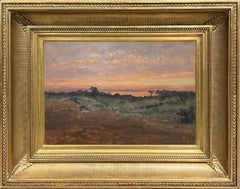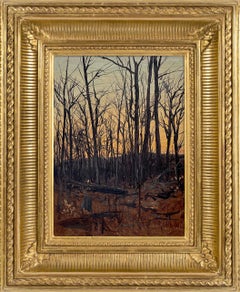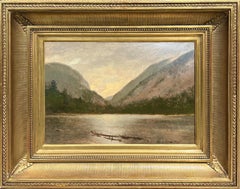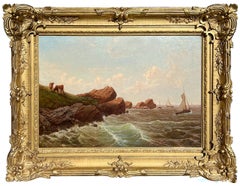Want more images or videos?
Request additional images or videos from the seller
1 of 8
Ludwig Bemelmans, 1898-1962New York Airport by Ludwig Bemelmans (Austrian-American, 1898–1962)
$38,500List Price
About the Item
- Creator:Ludwig Bemelmans, 1898-1962 (1898 - 1962, American)
- Dimensions:Height: 40 in (101.6 cm)Width: 31 in (78.74 cm)
- Medium:
- Period:
- Condition:
- Gallery Location:New York, NY
- Reference Number:1stDibs: LU2151212270502
About the Seller
5.0
Recognized Seller
These prestigious sellers are industry leaders and represent the highest echelon for item quality and design.
Established in 2004
1stDibs seller since 2022
5 sales on 1stDibs
Authenticity Guarantee
In the unlikely event there’s an issue with an item’s authenticity, contact us within 1 year for a full refund. DetailsMoney-Back Guarantee
If your item is not as described, is damaged in transit, or does not arrive, contact us within 7 days for a full refund. Details24-Hour Cancellation
You have a 24-hour grace period in which to reconsider your purchase, with no questions asked.Vetted Professional Sellers
Our world-class sellers must adhere to strict standards for service and quality, maintaining the integrity of our listings.Price-Match Guarantee
If you find that a seller listed the same item for a lower price elsewhere, we’ll match it.Trusted Global Delivery
Our best-in-class carrier network provides specialized shipping options worldwide, including custom delivery.You May Also Like
El Coyote Food Dreams - Abstract Restaurant Still Life Pop Art by Gary John
By Gary John
Located in Los Angeles, CA
Los Angeles street artist Gary John exploded onto the international art scene first during Art Basel Miami in 2013. John’s playfully bold work quickly gained attention and he was nam...
Category
21st Century and Contemporary Pop Art Landscape Paintings
Materials
Paper, Oil Pastel, Ink, Mixed Media, Acrylic, Illustration Board
Israeli Motke Blum Modernist Abstract Expressionist Oil Painting Bezalel Artist
By Motke Blum
Located in Surfside, FL
Motke Blum was born in Racacun, Romania in 1925. Early in his childhood, the Blum family moved to Bucharest where they settled in a house situated near a circus. The circus would become young Blum's greatest love. He befriended several of the clowns and other performers and, when not painting or playing in clay, Blum could be found enjoying the company of these spirited entertainers. These experiences would later become a recurring theme in many of his works of art.
In 1938, he was taken by the Romanian Iron Guard. When the Germans invaded Romania, Blum was taken to a forced labor camp. Even during his imprisonment, he continued to create art, painting on the walls of the camp. He escaped the Nazi camp in 1944 and boarded an immigrants' ship to Israel. One of the three ships in the convoy was sunk by a German torpedo. Motke later incorporated shipwrecks, boats, and other maritime subjects into several of his paintings.
Studies, Bezalel, Jerusalem, Enamel, Silversmithing, Painting and Sculpture.
1956 Seminar in the dep. of design in the royal silver factory of Zeist, The Netherlands.
Over the course of his long and fruitful career, Blum showed internationally at over fifty one-man-shows with exhibits in Israel, Holland, England, Belgium, the United States, France, Australia, and more. His art has been commissioned for public buildings and by prominent figures in Israel and around the world, and a series of posters were commissioned by the Justice Ministry and the Ministry of Tourism.
Group exhibition
Rina Gallery, Jerusalem
Artists: Motke Blum, Efraim Fima (Roytenberg, Ephraim) Zelig Segal, David Sharir, Joseph Halevi...
Category
20th Century Modern Abstract Paintings
Materials
Mixed Media, Oil, Illustration Board
$1,400
H 13.75 in W 18.5 in
Motorsport Car Racing with Checkered Flag at Finish Line of a Race Track
By Bob Peak
Located in Miami, FL
This highly innovated Bob Peak Race Track painting is a perfect synthesis of art and commerce. Designed with a radical composition where two-thirds of the picture plane is an alm...
Category
1960s Abstract Impressionist Landscape Paintings
Materials
Acrylic, Mixed Media, Illustration Board, Pencil
$16,000
H 16.25 in W 17.5 in
Elm Trees in Autumn Landscape in Antique Newcomb-Macklin Frame
By Mary H. Brubaker
Located in Soquel, CA
Elm trees in autumn at the edge of Salt Creek, Illinois, by Mary H. Brubaker (American, b. 1891). Signed and dated "Mary H. Brubaker 35" in the lower left cor...
Category
1930s American Modern Landscape Paintings
Materials
Canvas, Oil, Illustration Board
$1,240 Sale Price
20% Off
H 25.5 in W 29.5 in D 1.5 in
Mid Century Carmel Valley Figurative Landscape -- The Roadside Grocer
By Edda Maxwell Heath
Located in Soquel, CA
Gorgeous figurative landscape of a Carmel roadside grocer by Edda Maxwell Heath (American, 1874 - 1972). Signed and dated lower left corner. Presented in giltwood frame. Image, 20"H ...
Category
1950s American Impressionist Landscape Paintings
Materials
Oil, Illustration Board
$2,800 Sale Price
20% Off
H 27.5 in W 31.5 in D 1.25 in
Driftwood on the Beach, Mid Century Coastal Landscape
By Genevieve Rogers
Located in Soquel, CA
Beautiful mid century coastal landscape painting of driftwood at the beach by California artist Genevieve Rogers (American, 1904-1984). From a collection of her work. Unframed. Image...
Category
Mid-20th Century American Impressionist Landscape Paintings
Materials
Canvas, Oil, Illustration Board
$260 Sale Price
20% Off
H 12 in W 9 in D 1 in
Wells Fargo Express, Gold Country -- Columbia, California
By Cecil F. Chamberlin
Located in Soquel, CA
Charming oil painting of the Wells Fargo Express Office building in the gold country town of Columbia State Historic Park in Columbia, California by Cecil ...
Category
1950s American Impressionist Landscape Paintings
Materials
Canvas, Oil, Illustration Board
$1,320 Sale Price
20% Off
H 27 in W 30.75 in D 2 in
The Cascades Landscape in Oil on Artist's Board
By Walter F. MacGregor
Located in Soquel, CA
Colorful landscape by American artist Walter F. MacGregor (American, 1890-1979). Dated and signed "1969 Walter F. MacGregor" in the lower right corner. Presented in a dark wood frame...
Category
1960s American Impressionist Landscape Paintings
Materials
Canvas, Oil, Illustration Board
$600 Sale Price
20% Off
H 21.75 in W 25.5 in D 2 in
Mid-20th Century Oil on Board Abstract Impressionist Maritime Scene, René Genis
By René Genis
Located in Berlin, MD
Step into the bustling energy of a portside moment with René Genis’ “Les Grues” (The Cranes)”, a captivating oil-on-mat-board painting that transforms the in...
Category
Late 20th Century Abstract Impressionist Landscape Paintings
Materials
Oil, Illustration Board
$2,350
H 20.625 in W 25.625 in D 1 in
Last Light
Located in Denver, CO
Devin Michael Robert's "Last Light" is an original, handmade oil painting that depicts a rendering of a landscape.
Category
21st Century and Contemporary Figurative Paintings
Materials
Gouache, Illustration Board
More From This Seller
View AllNew England Sunrise, 1910 by Lockwood DeForest (American, 1850-1932)
Located in New York, NY
"New England Sunrise," 1910 by Hudson River School painter Lockwood DeForest (American, 1850-1932) is oil on artists card-stock and measures 9.75 x 14 inches. The work is signed by DeForest and dated Sept. 17, 1910 at lower left. The work is framed in an elegant, period appropriate frame, and ready to hang.
Lockwood de Forest was born in New York in 1850 to a prominent family. He grew up in Greenwich Village and on Long Island at the family summer estate in Cold Spring Harbor. As was customary for a cultivated family in the Gilded Age, the de Forests made frequent trips abroad. Excursions to the great museums, which were prominent on the de Forests agenda, deepened the young Lockwood's familiarity with European painting and sculpture. Though he had begun drawing and painting somewhat earlier, it was during a visit to Rome in 1868 that nineteen-year-old de Forest first began to study art seriously, taking painting lessons from the Italian landscapist Hermann David Salomon Corrodi (1844–1905). More importantly, on the same trip, Lockwood met one of America’s most celebrated painters, (and his maternal great-
uncle by marriage) Frederic Edwin Church (1826–1900), who quickly became his mentor. DeForest accompanied Church on sketching trips around Italy and continued this practice when they both returned to America in 1869. Early on in his career, de Forest made a habit of recording the date and often the place of his oil sketches, as to create a visual diary of his travels. Lockwood’s profession as a landscape painter can be primarily attributed to Frederic E. Church and his belief in the young artist’s talent.
De Forest often visited Church in the Hudson River community of Catskill where, in addition to sketching trips and afternoons of painting, he assisted with the architectural drawings and planning of Olana. In 1872, de Forest took a studio at the Tenth Street Studio Building in New York. During these formative years de Forest counted among his friend’s artists such as Sanford Robinson Gifford (1823–80), George Henry Yewell (1830–1923), John Frederick Kensett (1816–72), Jervis McEntee (1828–91), and Walter Launt Palmer (1854–1932).
Over the next decade de Forest experienced success as a painter. He exhibited for the first time at the National Academy of Design in 1872, and made two more painting trips abroad, in 1875–76 and 1877–78, traveling to the major continental capitals but also the Middle East and North Africa. His trip to the Middle East and the library at Church’s home, Olana, established his interest in design during his mid-twenties. From about 1878 to 1902, landscape painting was overshadowed by his activities and preoccupation with East Indian architecture and décor, a style that became quite fashionable in late nineteenth century America. From 1879-1883, de Forest founded Associated Artists along with Louis Comfort Tiffany, Candace Wheeler...
Category
Early 20th Century Hudson River School Landscape Paintings
Materials
Oil, Board
Dusk Forest Scene, Catskills by Lockwood DeForest (American, 1850-1932)
Located in New York, NY
"Dusk Forest Scene, Catskills," 1875 by Hudson River School painter Lockwood DeForest (American, 1850-1932) is oil on artists card-stock and measures 9.5 x 7 inches. The work is signed by DeForest, and dated May 13, 1875 at lower right. The work is framed in an elegant, period appropriate frame, and ready to hang.
Lockwood de Forest was born in New York in 1850 to a prominent family. He grew up in Greenwich Village and on Long Island at the family summer estate in Cold Spring Harbor. As was customary for a cultivated family in the Gilded Age, the de Forests made frequent trips abroad. Excursions to the great museums, which were prominent on the de Forests agenda, deepened the young Lockwood's familiarity with European painting and sculpture. Though he had begun drawing and painting somewhat earlier, it was during a visit to Rome in 1868 that nineteen-year-old de Forest first began to study art seriously, taking painting lessons from the Italian landscapist Hermann David Salomon Corrodi (1844–1905). More importantly, on the same trip, Lockwood met one of America’s most celebrated painters, (and his maternal great-
uncle by marriage) Frederic Edwin Church (1826–1900), who quickly became his mentor. DeForest accompanied Church on sketching trips around Italy and continued this practice when they both returned to America in 1869. Early on in his career, de Forest made a habit of recording the date and often the place of his oil sketches, as to create a visual diary of his travels. Lockwood’s profession as a landscape painter can be primarily attributed to Frederic E. Church and his belief in the young artist’s talent.
De Forest often visited Church in the Hudson River community of Catskill where, in addition to sketching trips and afternoons of painting, he assisted with the architectural drawings and planning of Olana. In 1872, de Forest took a studio at the Tenth Street Studio Building in New York. During these formative years de Forest counted among his friend’s artists such as Sanford Robinson Gifford (1823–80), George Henry Yewell (1830–1923), John Frederick Kensett (1816–72), Jervis McEntee (1828–91), and Walter Launt Palmer (1854–1932).
Over the next decade de Forest experienced success as a painter. He exhibited for the first time at the National Academy of Design in 1872, and made two more painting trips abroad, in 1875–76 and 1877–78, traveling to the major continental capitals but also the Middle East and North Africa. His trip to the Middle East and the library at Church’s home, Olana, established his interest in design during his mid-twenties. From about 1878 to 1902, landscape painting was overshadowed by his activities and preoccupation with East Indian architecture and décor, a style that became quite fashionable in late nineteenth century America. From 1879-1883, de Forest founded Associated Artists along with Louis Comfort Tiffany, Candace Wheeler...
Category
19th Century Hudson River School Landscape Paintings
Materials
Oil, Board
Hudson Highlands by Lockwood DeForest (American, 1850-1932)
Located in New York, NY
"Hudson Highlands," by Hudson River School painter Lockwood DeForest (American, 1850-1932) is oil on artists card-stock and measures 9.5 x 14 inches. The work is framed in an elegant, period appropriate frame, and ready to hang.
Lockwood de Forest was born in New York in 1850 to a prominent family. He grew up in Greenwich Village and on Long Island at the family summer estate in Cold Spring Harbor. As was customary for a cultivated family in the Gilded Age, the de Forests made frequent trips abroad. Excursions to the great museums, which were prominent on the de Forests agenda, deepened the young Lockwood's familiarity with European painting and sculpture. Though he had begun drawing and painting somewhat earlier, it was during a visit to Rome in 1868 that nineteen-year-old de Forest first began to study art seriously, taking painting lessons from the Italian landscapist Hermann David Salomon Corrodi (1844–1905). More importantly, on the same trip, Lockwood met one of America’s most celebrated painters, (and his maternal great-
uncle by marriage) Frederic Edwin Church (1826–1900), who quickly became his mentor. DeForest accompanied Church on sketching trips around Italy and continued this practice when they both returned to America in 1869. Early on in his career, de Forest made a habit of recording the date and often the place of his oil sketches, as to create a visual diary of his travels. Lockwood’s profession as a landscape painter can be primarily attributed to Frederic E. Church and his belief in the young artist’s talent.
De Forest often visited Church in the Hudson River community of Catskill where, in addition to sketching trips and afternoons of painting, he assisted with the architectural drawings and planning of Olana. In 1872, de Forest took a studio at the Tenth Street Studio Building in New York. During these formative years de Forest counted among his friend’s artists such as Sanford Robinson Gifford (1823–80), George Henry Yewell (1830–1923), John Frederick Kensett (1816–72), Jervis McEntee (1828–91), and Walter Launt Palmer (1854–1932).
Over the next decade de Forest experienced success as a painter. He exhibited for the first time at the National Academy of Design in 1872, and made two more painting trips abroad, in 1875–76 and 1877–78, traveling to the major continental capitals but also the Middle East and North Africa. His trip to the Middle East and the library at Church’s home, Olana, established his interest in design during his mid-twenties. From about 1878 to 1902, landscape painting was overshadowed by his activities and preoccupation with East Indian architecture and décor, a style that became quite fashionable in late nineteenth century America. From 1879-1883, de Forest founded Associated Artists along with Louis Comfort Tiffany, Candace Wheeler...
Category
19th Century Hudson River School Landscape Paintings
Materials
Oil, Board
Cattle by the Sea, c. 1867 by Ann Sophia Towne Darrah (American, 1819-1881)
Located in New York, NY
"Cattle by the Sea," c. 1867 by historic woman artist Ann Sophia Towne Darrah (American, 1819-1881) was exhibited at the Pennsylvania Academy of the Fine Arts in 1867. Painted in oil...
Category
19th Century Hudson River School Landscape Paintings
Materials
Oil, Canvas
View of Lake Champlain, c. 1857 by James MacDougal Hart (American: 1828–1901)
By James McDougal Hart
Located in New York, NY
JAMES MCDOUGAL HART (1828–1901)
View of Lake Champlain, c. 1857
Oil on canvas
26 3/16 x 36 1⁄4 inches
Signed lower center
Exhibition History: National ...
Category
19th Century Hudson River School Landscape Paintings
Materials
Oil
Summer at the Farm by James McDougal Hart (American, 1828-1901)
By James McDougal Hart
Located in New York, NY
"Summer at the Farm," by Hudson River School painter James McDougal Hart (American, 1833-1915) is oil on canvas and measures 14 x 24 inches. It is signed and dated by Hart at the low...
Category
19th Century Hudson River School Landscape Paintings
Materials
Canvas, Oil
Recently Viewed
View AllMore Ways To Browse
Utrecht Art
French Impressionist Paintings 1900
Gloucester Massachusetts
Oil Paintings Of Venice
Painting English Countryside
Painting Trolley
Skyscapes Art
Thames Painting
Winter Scene Paintings
1975 Oil Painting
American Farm Art
Gordon Oil Painting
Impressionist Sailboat Paintings
Royal Marines
Best Sellers
French Painting Horse And Carriage
Impressionist Poppies
Landscape Oil Painting Market



